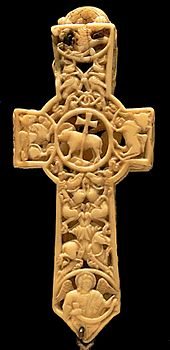
Back অসমৰ হাতী দাঁত শিল্প Assamese Eborària Catalan Elfenbeinschnitzerei German Ελεφαντουργική Greek Eboraria Spanish عاجکاری Persian Ivoire (sculpture) French Ukiran gading ID Ivoorsnijwerk Dutch Plastyka z kości słoniowej Polish


Ivory carving is the carving of ivory, that is to say animal tooth or tusk, generally by using sharp cutting tools, either mechanically or manually. Objects carved in ivory are often called "ivories".
Humans have ornamentally carved ivory since prehistoric times, though until the 19th-century opening-up of the interior of Africa, it was usually a rare and expensive material used for small luxury products. Very fine detail can be achieved, and as the material, unlike precious metals, has no bullion value and usually cannot easily be recycled, the survival rate for ivory pieces is much higher than for those in other materials. Ivory carving has a special importance to the medieval art of Europe because of this, and in particular for Byzantine art as so little monumental sculpture was produced or has survived.[1]
As the elephant and other ivory-producing species have become endangered, largely because of hunting for ivory, CITES and national legislation in most countries have reduced the modern production of carved ivory.
- ^ Williamson, 5–6